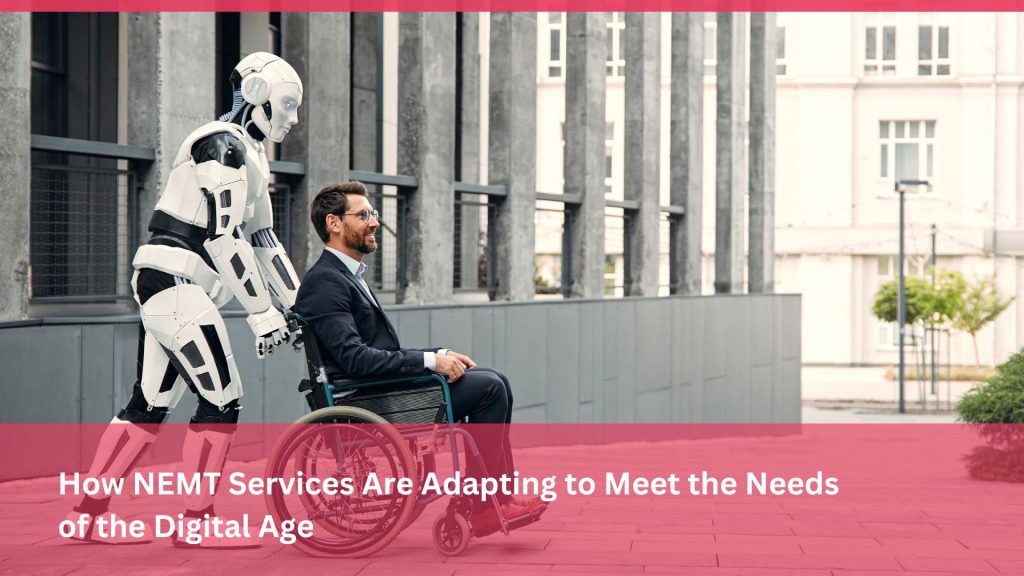New at Safr Care
How NEMT Services Are Adapting to Meet the Needs of the Digital Age

How NEMT Services Are Adapting to Meet the Needs of the Digital Age
Non-Emergency Medical Transportation (NEMT) services have always focused on ensuring safe, reliable rides for patients who face transportation barriers. However, as technology continues to reshape healthcare, NEMT providers are embracing digital innovations to streamline scheduling, enhance communication, and improve overall efficiency. This article explores how NEMT services are adapting to meet the demands of the digital age, ultimately creating a more patient-centered and cost-effective transportation experience.
1. Advanced Scheduling and Route Optimization
Traditional pen-and-paper methods for booking rides can be time-consuming and prone to errors. Modern NEMT providers are implementing sophisticated software and algorithms to simplify and improve this process:
- Automated Booking Systems: Patients or healthcare facilities can schedule rides online, often receiving immediate confirmations without lengthy phone calls.
- Route Optimization Tools: Intelligent mapping software finds the most efficient paths, reducing travel time and fuel costs while accommodating multiple pick-ups or drop-offs.
- Real-Time Updates: Dispatchers monitor traffic conditions or unexpected delays, adjusting routes on the fly to maintain on-time arrivals.
This level of automation ensures punctuality, less waiting, and a more seamless experience for both patients and providers.
2. Mobile Apps and Real-Time Tracking
In a world where smartphones are ubiquitous, many NEMT services have developed mobile applications that give patients and caregivers more control over their rides:
- Ride Status Notifications: Passengers receive alerts when the driver is en route, has arrived, or if any delays occur.
- GPS Tracking: Patients and families can follow the vehicle’s location in real-time, reducing anxiety about estimated arrival times.
- In-App Communication: Users can message drivers or support staff directly, clarifying pick-up points, last-minute appointment changes, or special requests.
By incorporating mobile tools, NEMT providers enhance transparency and convenience, key factors in modern healthcare delivery.
3. Telehealth Integration and Collaborative Care
As telehealth services rise in popularity, NEMT providers are exploring ways to coordinate rides with virtual care appointments or integrate supportive technologies:
- Transport to Telehealth Hubs: Some patients may not have reliable internet at home. NEMT can bring them to community telehealth centers equipped with high-speed connections and remote monitoring tools.
- Coordinated Schedules: Drivers align transport times with telehealth sessions, lab visits, or in-person check-ups for a unified care plan.
- Data Sharing: Partnerships with healthcare providers allow streamlined updates on ride status, ensuring doctors or therapists know when a patient is en route or delayed.
This synergy between NEMT and digital healthcare solutions supports a more cohesive, continuous patient experience.
4. Enhanced Security and Compliance
As NEMT becomes more digitized, addressing privacy and regulatory standards remains paramount. Modern systems often feature:
- Secure Data Handling: Encryption and secure server protocols protect patient information shared during scheduling or route planning.
- HIPAA Compliance: Many NEMT dispatch and communication platforms meet healthcare privacy regulations, ensuring confidentiality.
- Driver Verification: Background checks and digital driver records promote accountability and passenger safety.
By weaving these protections into digital tools, providers uphold patient trust and meet mandated healthcare requirements.
5. Data-Driven Insights for Better Service
Collecting and analyzing ride-related data enables NEMT providers to identify trends, optimize operations, and improve patient outcomes. Some advanced usage includes:
- Predictive Analytics: Examining demand patterns helps allocate vehicles effectively, minimizing wait times and overbooking.
- Performance Tracking: Metrics on driver punctuality, trip durations, and patient feedback inform staff training and service refinements.
- Community Health Planning: Insights into frequent routes or underserved regions guide partnerships with local clinics or outreach programs.
A data-informed approach not only boosts operational efficiency but also fosters more strategic healthcare collaboration.
Choosing a Tech-Savvy NEMT Provider
When seeking an NEMT provider that keeps pace with digital innovations, look for services emphasizing:
- Modern Scheduling Platforms: Online booking or mobile apps that simplify ride coordination for patients, caregivers, and providers alike.
- Real-Time Driver Tracking: GPS updates and ETA notifications reduce anxiety, ensuring patients can plan accordingly.
- Integrated Security Features: HIPAA-compliant data handling and driver verification processes safeguard privacy.
Examples like SafrCare demonstrate how cutting-edge tech, combined with compassionate service, can reshape patient transportation experiences.
Conclusion
As healthcare delivery evolves in the digital era, NEMT services are stepping up to match these changes. By adopting advanced scheduling systems, real-time apps, telehealth integration, and robust data analysis, modern NEMT providers can deliver more timely, efficient, and patient-friendly transport solutions. These technological strides not only simplify logistics but also help reduce missed appointments, support proactive care management, and enhance overall patient satisfaction.
In a rapidly transforming healthcare landscape, investing in a technologically adept NEMT provider is a strategic choice—ensuring that transportation remains an enabler rather than a barrier to high-quality, accessible care. With the right combination of innovation and empathy, NEMT services will continue to play a pivotal role in closing gaps and delivering seamless support to those who need it most.
